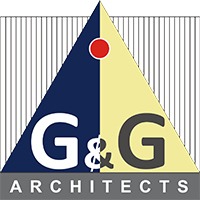Envisioning Post- Pandemic Architecture Practise
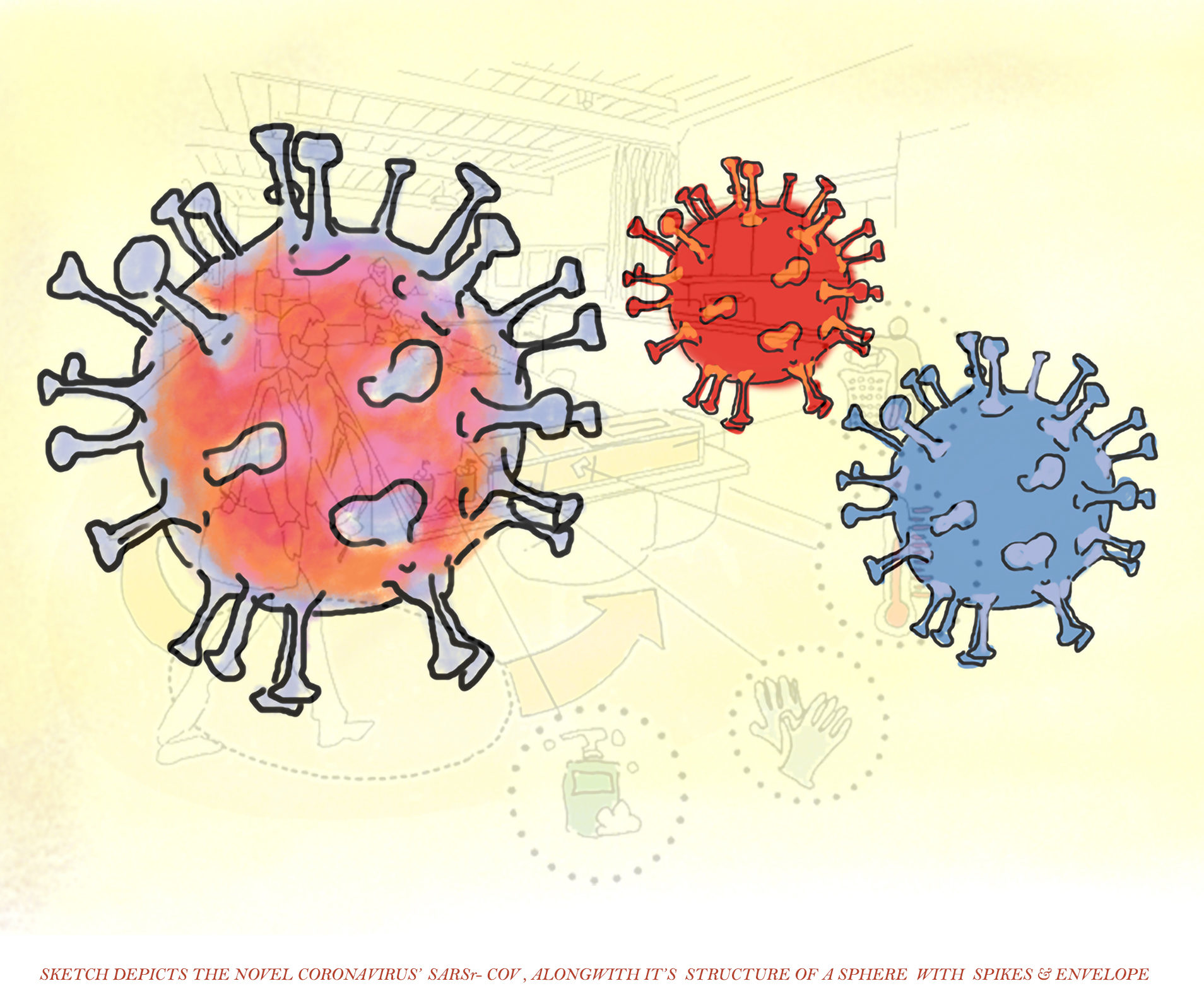
Envisioning Post- Pandemic Architecture Practise
EXPLORING THE SCOPE OF EVOLUTION OF ARCHITECTURE INDUSTRY POST- COVID -19 WITH SET OF GUIDELINES & REGULATIONS FOR OPERATION OF ARCHITECTURE FIRMS GLOBALLY, ALSO
FOLLOWED BY GAUTAM & GAUTAM ASSOCIATES
Current Architectural Issues Series I Ar. Ankur Gautam I Gautam & Gautam Associates I 2 JUNE,2020
The Universe within the space- time continuum is in a continues state of order and chaos and our planet within this vast multiverse is a miniscule fraction of that. On a human scale, this balance is in continuous flux, majorly influenced by our actions with each fraction of time. It is the imbalance and chaos amidst the planet’s species & nature that is currently leading to a multitude of consequences from global warming to disturbed climatic patterns to the spreading of deadly diseases.
One such epidemic presently an incurable pandemic- the noble Coronavirus is a drastic consequence at an unprecedented surge. It is evident from the past pandemics that each time humans have tried to interfere with the human- nature relationship, devastating effects have been dawned upon our species. Though in such testing times our species has adapted and evolved in the given situations, still we do not take lessons from our misdeeds and fell folly to such deadly viruses each time.
Such situations tests the strength & preparedness of societal & political fabric of the countries, greatly affecting the economic & labour- intensive sectors. Many private & public sectors around the globe are experiencing a major economic setback with an immediate requirement to transform their work mechanism & methodology according to the given situations. One such profession – Architecture & Design is also in a transition of global evolution & transformation.
Architecture being as the forefront medium of harmonious existence of our species with nature is highly responsive to such causes, be it global warming or pandemics. Be it the issues like surge in global temperatures leading to increase in green landscape zones, parameters to reduce heat- island effect or global warming which has lead to proceed towards green building techniques, Architecture & design has always aided humans to re-establish the balance with nature harmoniously.
With nature in complete bloom & human activities under complete lockdown, it is the need of the hour to look upon & change our ways of communications with nature. This can be through switching to green technologies in transportation, industrial and construction industry, converting heat- island creator roads to greens, pedestrianizing large row’s and promoting our ways of living in ways complementing to nature. The current pandemic has also lead to realization to expand the present inadequate health infrastructure, with area programs according to the anthropometrics of the spaces required for the cure & treatment of same.
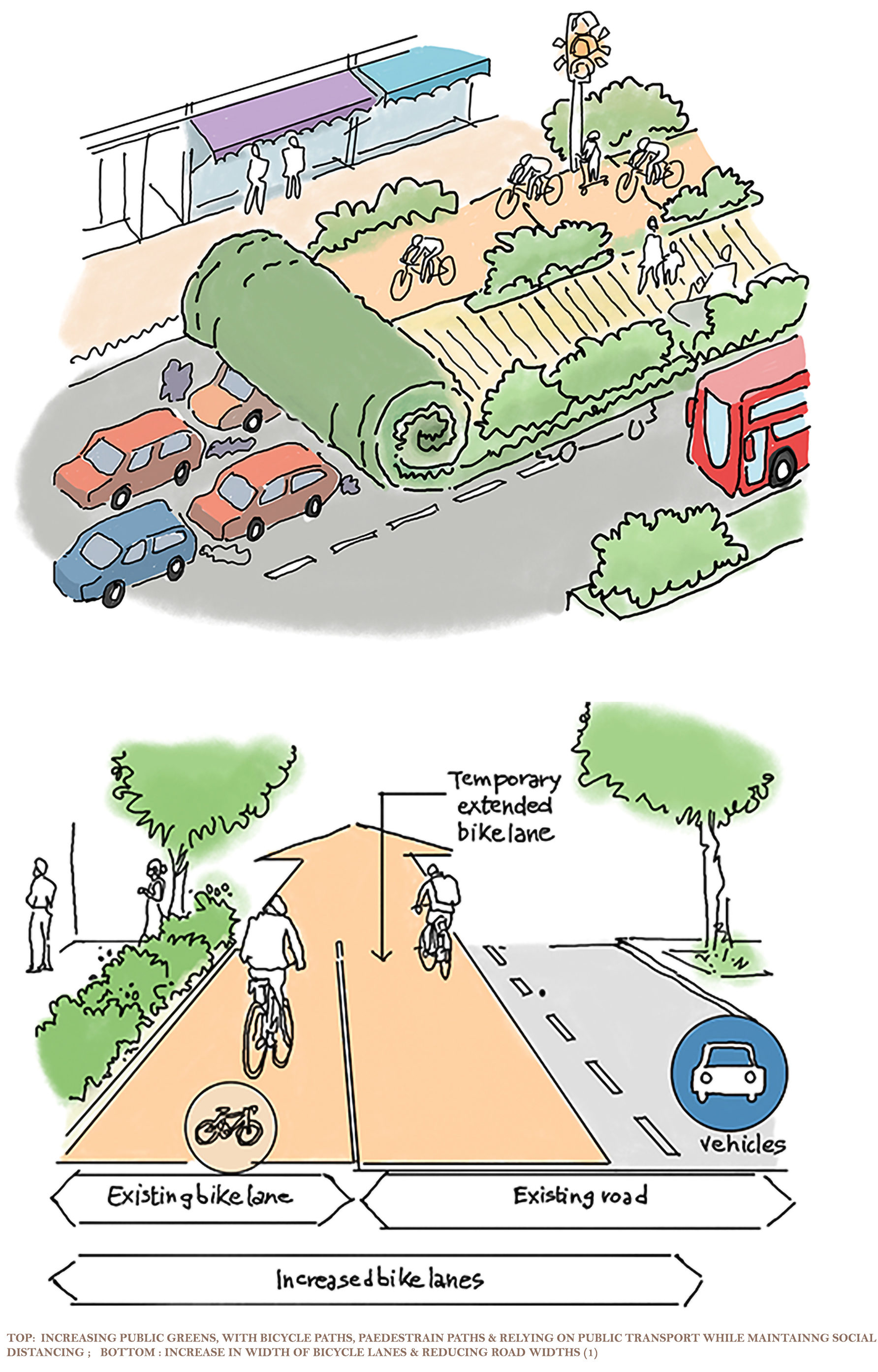
PANDEMIC’S EFFECT ON ARCHITECTURAL OFFICES’ FUNCTIONING
Reduction in pollution during lockdowns have unlocked a new dimension of urban transformation , lead by technology & co-working hand in hand. This can be through decentralization of offices or work spaces and establishing & expanding a co-working spatial cultures, with venues distributed across the city.
Recent technological advancements and their continent access have introduced an alternative domain of working methodology & working spaces for Architecture Offices & firms across the globe. The efficient server & remote connection systems have lead to a convenient work from home methodology, transforming both the work methodology & work spaces of the present generation of Architects & designers. Online meeting & video conferencing platforms like Zoom, Goggle Meet, etc have enabled inter- territorial interactions & discussions amongst the folks. This has not only reduced the travel time previously required to access the workspaces, but has also lead to flexibility in working hours & comfort within the home. On the contrary, the work from home staff members seem to make modifications in their living spaces, to incorporate a work station & workplace, devoid of any family disturbance & completing their tasks in a disciplined manner. Reduced face-to – face interactions social gatherings, site visits, travelling, etc can also have a deteriorating effect on a persons’ mental- emotional well- being & reduced creative visualization.
Restricted movement out of the houses with unexpected & time- to time sealing of inter- state borders & restrictions in air & rail travel have made it difficult for the Architecture fraternity to fetch & execute projects in other states or countries , with returning back of construction workers & labour class back to their houses making the situation worse.
Unlocking this containment is a responsibility of the government on the side of devising norms & guidelines and following those an undeniable fact for the public. As the norms on functioning of private Architectural offices favour towards a staggered operation, so does the threat of further spreading of the virus aggravates. Although with certain precautionary guidelines & regulations the spreading of virus can be contained, it is inevitably up to the disciplined adoption of those by the public.

Regulations like a 2 Metre distance between 2 staff members will always be inevitable during & after office hours is pivotal to be followed by all. Some other guidelines includes pointers like modification in working hours according to curfew hours and allowing work from home for staff members living too far or not having any private mode of transportation. The ease in regulations on metro travel will also affect the staff transportation security, with each traveller to follow guidelines issued by metro authority. Following those, the staff shall also follow norms of seating with alternate seats left vacant & while standing , maintaining same social distance. On positive side, this will reduce rush & over congestion in metros, providing a convenient public transportation.
Working in office can take place in shifts where a same project related work is provided to each shift’s team. The total strength can be divided to 2 or 3 teams as per the office staff strength with teams to function alternatively on group of days like Monday- Tuesday, Wednesday- Thursday, Friday- Saturday. On rest of the days those groups shall function on work from home methodology accordingly. This will provide more flexibility in office spaces required for social distancing & convenient work conditions.


The meetings in compact conference rooms shall be avoided and open spaces in offices shall be used for same, maintaining social distance. The offices shall be equipped with smart technologies like hands- free attendance equipment, hand gesture sensor door openers, hands- free door handle with elbow round door- knob, IOT enabled lighting & air- conditioning control systems like Bluetooth lights, fans, ac equally accessible to all staff members.
In office cafes or break time eating spaces, staff members shall continue to maintain social distancing or shall eat at their own desks to avoid spreading of virus. Also, during break time hours the staff shall be restricted to exit the office perimeters for their own health safety. Toilet fixtures like taps , wc shall have automatic systems with sensors for hands free tap & wc use, alongwith sensor hand sanitizer present.
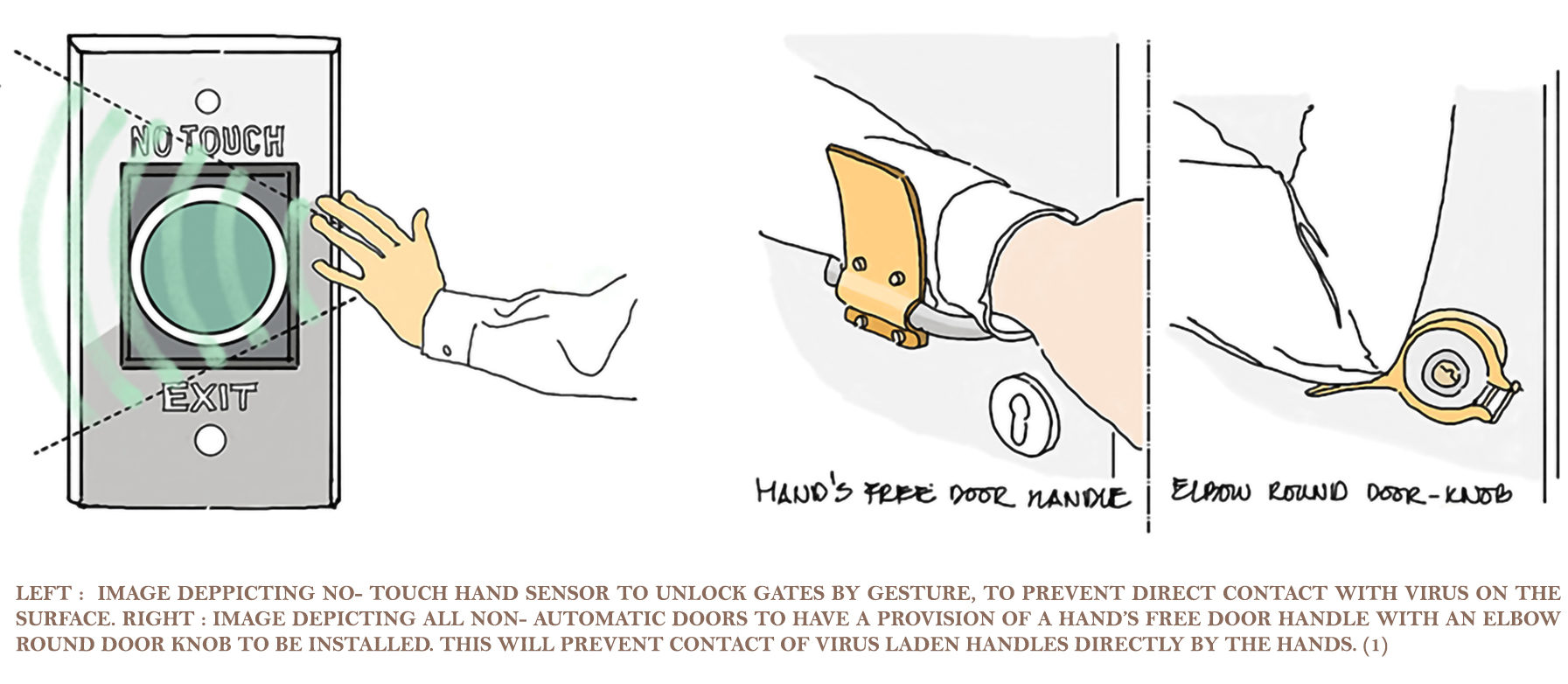

Their should also be a transparent partition between two tables to avoid contact of virus or every alternate work table should be left vacant for working in office while maintaining social distance. Also, the lifts shall be operated through foot peddles for stopping or calling a lift, rather than touching the buttons for the same. This will reduce chances of contact of virus through hands.

COUNCIL OF ARCHITECTURE’S GUIDELINES FOR ARCHITECTURE FIRMS
1. All roads, lawns, gardens, playgrounds etc. shall be thoroughly disinfected before re-use and the procedure should be repeated at least once a week.
2. Procedure shall be established for the disinfection method, type of medium, periodicity, log register shall be maintained and the same shall be supervised by the head of the establishment.
3. Appropriate personal protection equipment (PPE) like Face covers, Masks, Goggles, Gloves, Coats / Aprons, Shoes and appropriate disinfecting gadgets like sprayer, brush, etc shall be encouraged and if possible enough set of masks shall be made available at the premises. Hand sanitisers shall be made available at all accessible and appropriate places.
4. The procedure of disinfection shall be displayed at prominent places, easily readable and displayed prominently and adequately.
5. Appropriate changes in the working methodology and procedure shall be made to avoid crowding and maintaining the concept of social distance while working.
6. ERP attendance or Bio-metric fingers print roster is to be discouraged as far as possible and temporarily dis-continued.
7. Arrangement for signing of register or roster shall be made as an alternative method.
8. Work from home concept shall be encouraged and is to be implemented in all feasible spheres as far as possible. Alternatively, rotation schedule can be followed on alternate or weekly basis for the employees.
9. As far as possible, usage of bulk public transport shall be avoided, at-least until further instruction or as deem fit by the head of the establishment.
10. Everyone to use own vehicle for commuting as far as possible and sharing of any mode of conveyance shall be discouraged, at least until further notice or as deem fit by the head of the establishment.
11. In case of shared travel by staff, like cabs or mini bus or three wheelers, the occupancy shall be half of what is permitted usually by the relevant authority.
12. At least one doctor, nurse and a medical attendant shall be on call, and accessible immediately for medial emergencies.
13. Compulsory screening of all persons, visitors, students etc. irrespective of the status, entering the gate or premises with thermal scanner or an appropriate instrument wherein the body temperature can be checked and recorded.
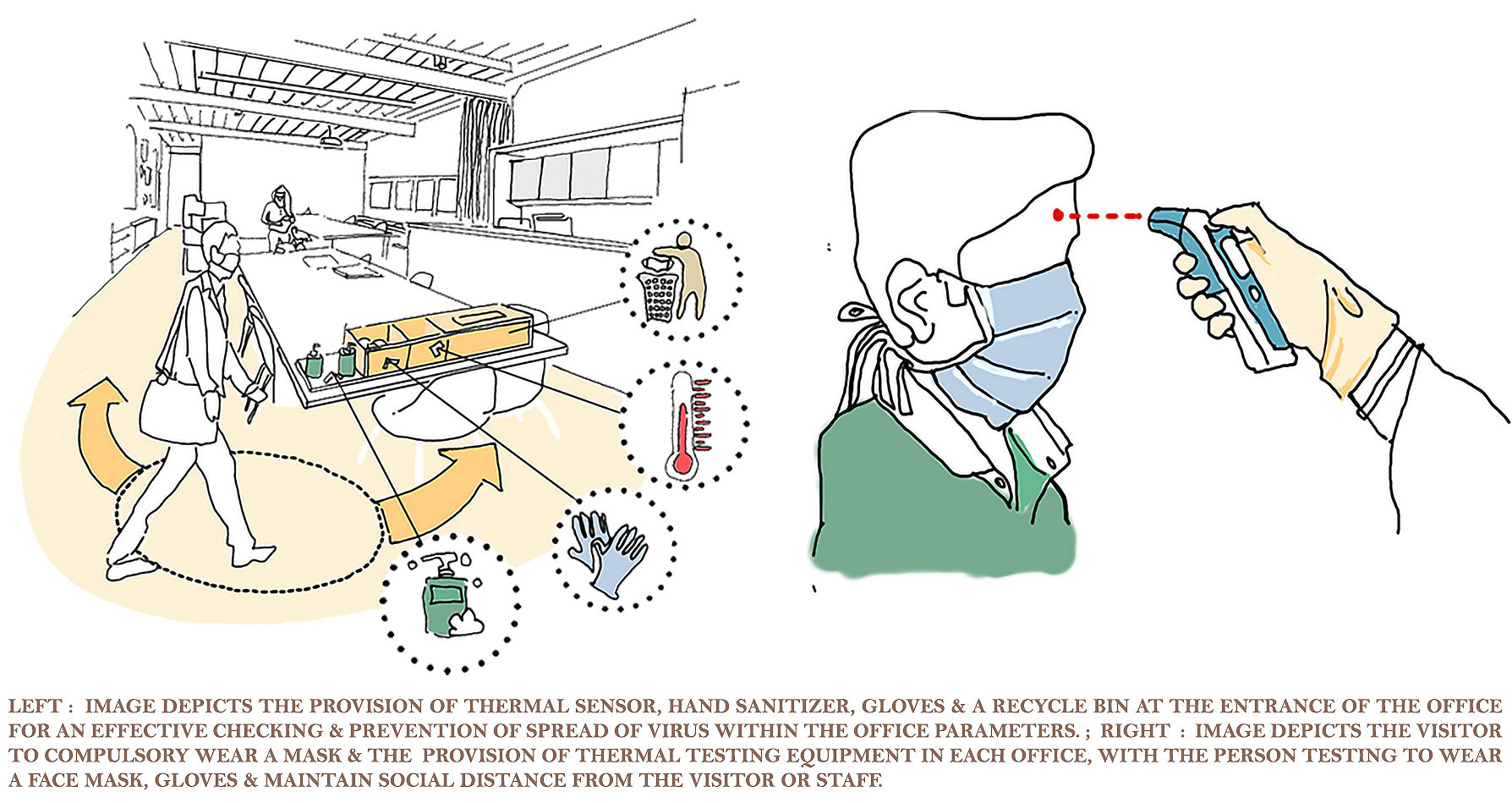
14. Stoppage of any person found having fever and cough and politely refused entry. If a breathing problem is discovered it has to be informed to the concerned department and the infected person shall be taken to nearest quarantine facility and later to govt hospital immediately for further testing.
15. Any parcel, courier or food delivery person should be stopped at gate. Parcel or to be delivered item shall be collected from the entry point by the concerned individual.
16. Everyone entering the premises shall be permitted inside only if they are using appropriate masks.
17. Everyone entering the premises shall be sanitized using sanitizers.
18. Hand sanitizers shall be kept ready the entrances and people after entry shall sanitize their hands before proceeding to their work places or elsewhere in the premises.
19. Employees shall work from their desks and avoid going to other’s, as far as possible.
20. To minimise possible discussions & interactions, these can be held through hand phones, intercoms and mobile phones.
21. Meetings are to be avoided and VC, Conf. calls or other modes should be used as replacement.
22. Everyone to strictly adhere to the social distance of minimum 1 meter.
23. Avoid use and carrying of hard copy files where ever possible and soft copy correspondences, approvals and other procedures is to be encouraged.
24. Approving officers can seek required back up and supporting documents in soft copy for study before according approval in soft copy itself. The hard copy approval can be endorsed after the advisory is lifted. This is to avoid major contamination risk.
25. As far as possible air-conditioned spaces are to be avoided and discouraged.
26. Workshops, seminars, conferences, convocations or similar activities should not be organised under any circumstances, until the advisory is lifted or further notification issued.
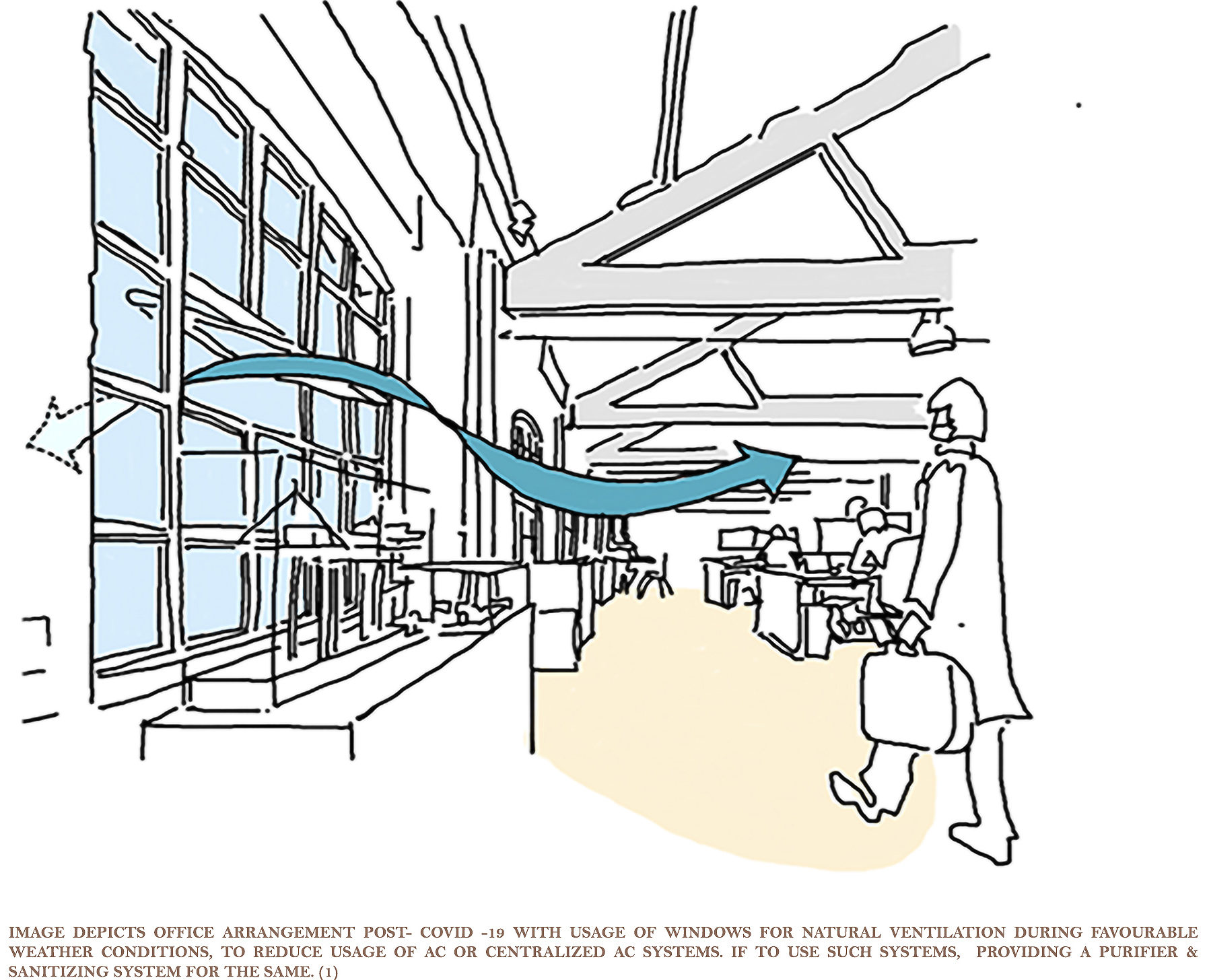
27. Avoid use of air-conditioning as far as possible and natural ventilation shall be used.
28. Ensure sanitization of all areas is done before start and after end of working hours.
29. Special attention is to be given to wash rooms, toilets and drinking water areas by periodical cleaning, swabbing, disinfecting and maintaining them dry.
30. All surfaces including Walls, Doors, Windows and all fittings and fixtures in wash rooms shall be disinfected and cleaned thoroughly and appropriately at least twice a day.
31. Soap solutions or hand sanitizers shall be placed and replenished periodically.
32. Face masks should not be reused.
33. The face masks shall be disposed off in closed bins or covered garbage boxes, preferably in independent ones and disposed off separately and treat as medical waste. Appropriate procedure shall be ensured for medical waste disposal as per standards
34. Sanitizers are highly inflammable and care shall be taken to not light a match, lighter or any other fire near the same one after use.
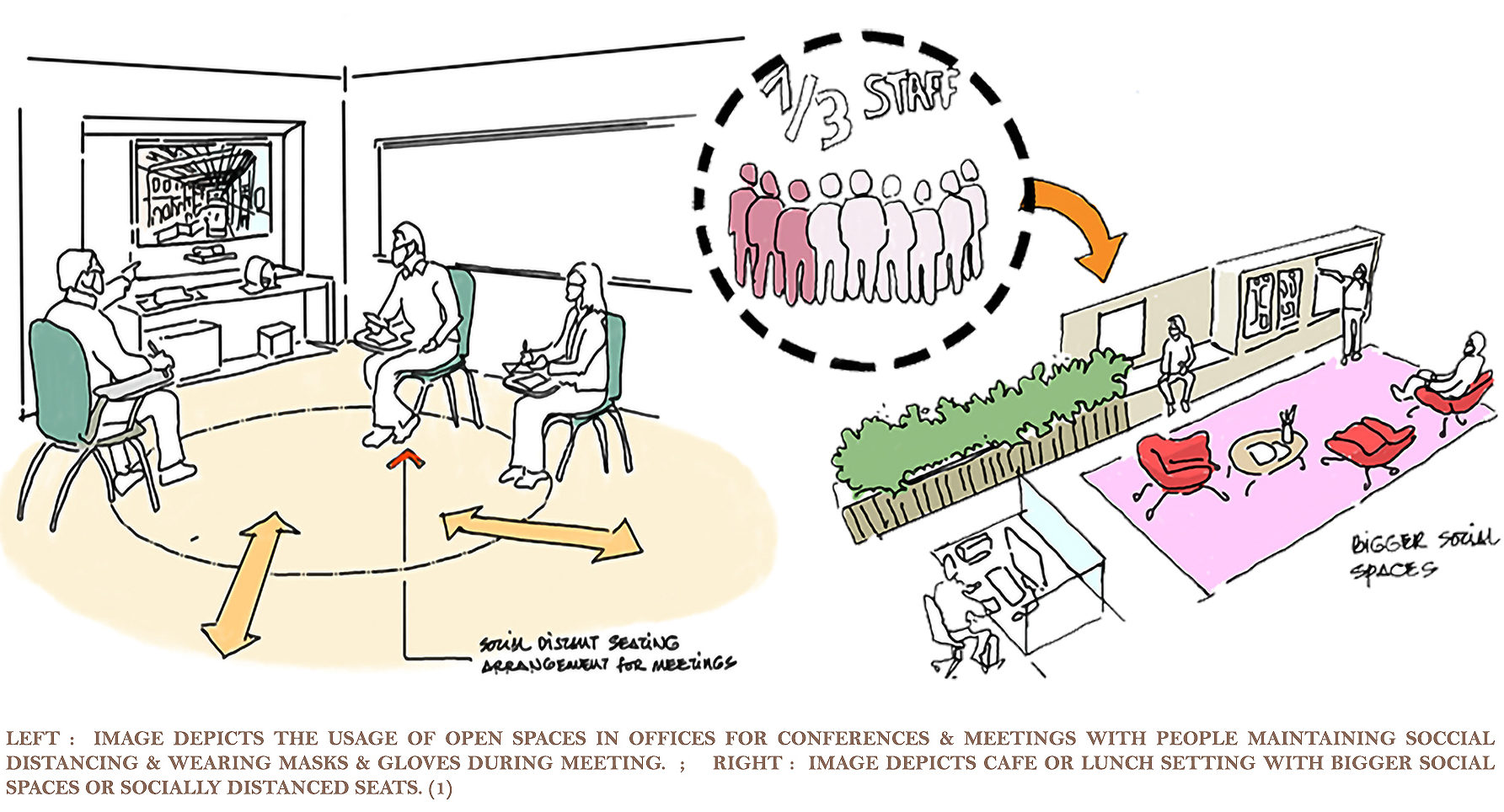
Apart from these, certain other measures includes :
1. Compulsory installation of Arogya App on staff mobiles with periodical inspection of same to be aware if anyone is coming from an indirect or direct exposure of the virus from their residential or movement surroundings.
2. Each staff member or any visitor carrying any bag or object shall be spray sanitized thoroughly before entering the premises.
3. Each staff member shall bring their own pocket hand sanitizer and should be placed at their respective tables to sanitize hands whenever they touch any switch or objects.
4. The Office entrance should be having a sanitizing door mat, effectively removing virus particles present around the shoes of the person.
5. The office premises shall be mopped at least 3 times a day to prevent spreading of virus through floors.
This pandemic has made the Architects, designers, policy makers, planners & governments to adapt and evolve with a greater resilience & change their perspective of looking at spaces, cities, world with an impulse to generate safe, virus free and a healthy environment for the well being of all the species. The world awaits a series of modifications & developments in future in domains of urban designing, planning, landscaping & functionality & programming hierarchy of indoor & outdoor spaces, transportation, construction and all other industries related to these. It is the utmost responsibility of the Architects to make themselves aware of the implications of covid-19 and measures to prevent those, to educate their staff & clients about the same & through this awareness, design spaces in future which remain functional & prevent spreading of this virus even during an outbreak of a similar one, further eliminating the need to lockdown & halt the economic activities.
Coronavirus COVID-19 has taught the humanity to pause in life & reflect upon our past actions, what can be learned from them and how through our input we can make this world a better place to live in & it is expected of the human species to take in valuable lessons from this pandemic and not to repeat those in near future. Stay safe, maintain social distance, stay indoors.
REFERENCES :
(1) BY WESTON WILLIAMSON + PARTNERS- SKETCHED , MODIFIED & ADAPTED BY AR. ANKUR GAUTAM : GAUTAM & GAUTAM ASSOCIATES
Developed by Abacus Desk

